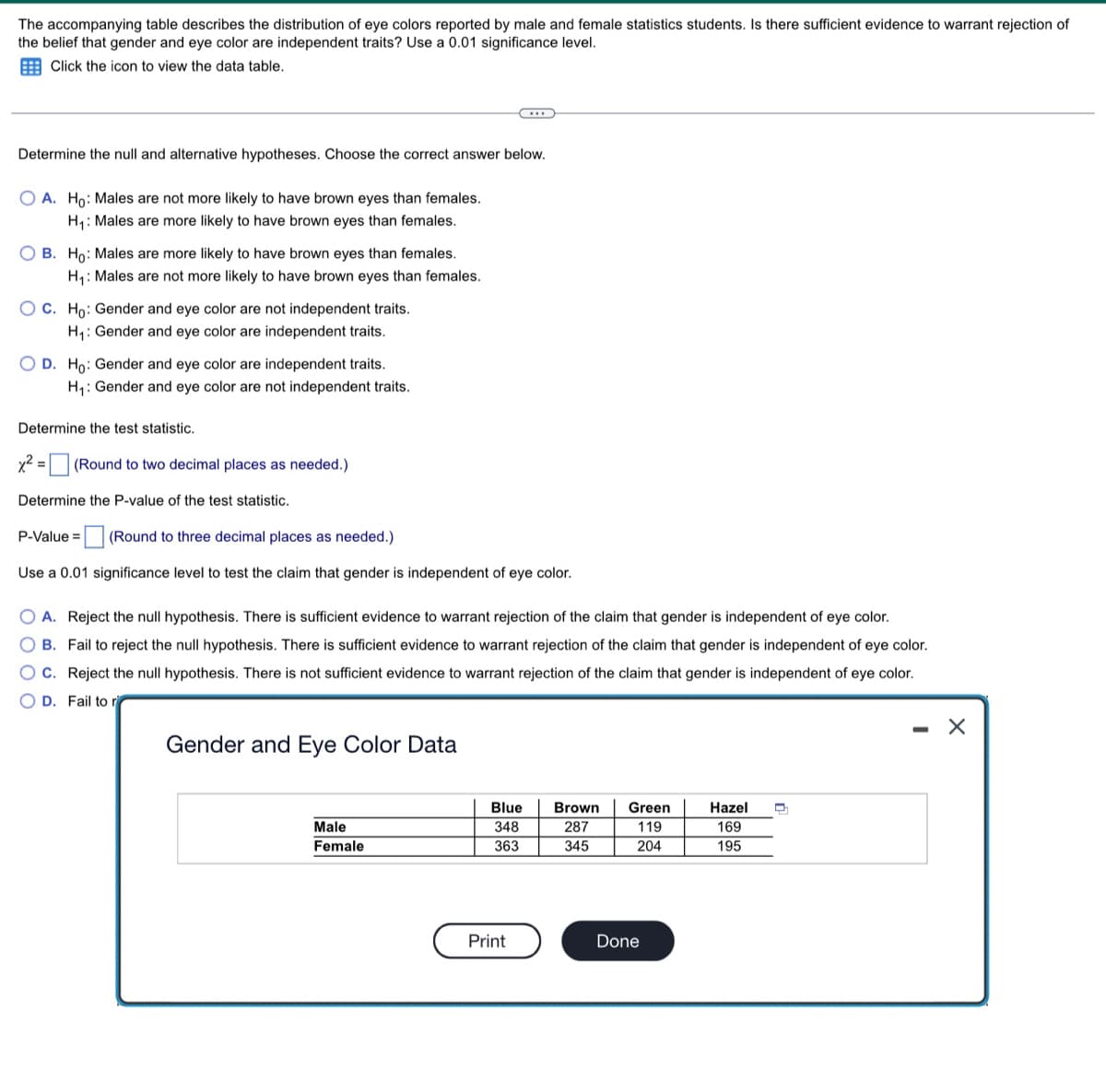The accompanying table describes the distribution of eye colors reported by male and female statistics students. Is there sufficient evidence to warrant rejection of the belief that gender and eye color are independent traits? Use a 0.01 significance level. Click the icon to view the data table. Determine the null and alternative hypotheses. Choose the correct answer below. O A. Ho: Males are not more likely to have brown eyes than females. H₁: Males are more likely to have brown eyes than females. OB. Ho: Males are more likely to have brown eyes than females. H₁: Males are not more likely to have brown eyes than females. OC. Ho: Gender and eye color are not independent traits. H₁: Gender and eye color are independent traits. O D. Ho: Gender and eye color are independent traits. H₁: Gender and eye color are not independent traits. Determine the test statistic. x² = (Round to two decimal places as needed.) Determine the P-value of the test statistic. P-Value = (Round to three decimal places as needed.) Use a 0.01 significance level to test the claim that gender is independent of eye color. O A. Reject the null hypothesis. There is sufficient evidence to warrant rejection of the claim that gender is independent of eye color. OB. Fail to reject the null hypothesis. There is sufficient evidence to warrant rejection of the claim that gender is independent of eye color. OC. Reject the null hypothesis. There is not sufficient evidence to warrant rejection of the claim that gender is independent of eye color. OD. Fail to r - X Gender and Eye Color Data Blue Brown Hazel D Green 119 Male 348 287 169 Female 363 345 204 195 Print Done
The accompanying table describes the distribution of eye colors reported by male and female statistics students. Is there sufficient evidence to warrant rejection of the belief that gender and eye color are independent traits? Use a 0.01 significance level. Click the icon to view the data table. Determine the null and alternative hypotheses. Choose the correct answer below. O A. Ho: Males are not more likely to have brown eyes than females. H₁: Males are more likely to have brown eyes than females. OB. Ho: Males are more likely to have brown eyes than females. H₁: Males are not more likely to have brown eyes than females. OC. Ho: Gender and eye color are not independent traits. H₁: Gender and eye color are independent traits. O D. Ho: Gender and eye color are independent traits. H₁: Gender and eye color are not independent traits. Determine the test statistic. x² = (Round to two decimal places as needed.) Determine the P-value of the test statistic. P-Value = (Round to three decimal places as needed.) Use a 0.01 significance level to test the claim that gender is independent of eye color. O A. Reject the null hypothesis. There is sufficient evidence to warrant rejection of the claim that gender is independent of eye color. OB. Fail to reject the null hypothesis. There is sufficient evidence to warrant rejection of the claim that gender is independent of eye color. OC. Reject the null hypothesis. There is not sufficient evidence to warrant rejection of the claim that gender is independent of eye color. OD. Fail to r - X Gender and Eye Color Data Blue Brown Hazel D Green 119 Male 348 287 169 Female 363 345 204 195 Print Done
Glencoe Algebra 1, Student Edition, 9780079039897, 0079039898, 2018
18th Edition
ISBN:9780079039897
Author:Carter
Publisher:Carter
Chapter10: Statistics
Section10.4: Distributions Of Data
Problem 19PFA
Related questions
Question

Transcribed Image Text:The accompanying table describes the distribution of eye colors reported by male and female statistics students. Is there sufficient evidence to warrant rejection of
the belief that gender and eye color are independent traits? Use a 0.01 significance level.
Click the icon to view the data table.
..
Determine the null and alternative hypotheses. Choose the correct answer below.
OA. Ho: Males are not more likely to have brown eyes than females.
H₁: Males are more likely to have brown eyes than females.
OB. Ho: Males are more likely to have brown eyes than females.
H₁: Males are not more likely to have brown eyes than females.
OC. Ho: Gender and eye color are not independent traits.
H₁: Gender and eye color are independent traits.
O D. Ho: Gender and eye color are independent traits.
H₁: Gender and eye color are not independent traits.
Determine the test statistic.
x² = (Round to two decimal places as needed.)
Determine the P-value of the test statistic.
P-Value =
(Round to three decimal places as needed.)
Use a 0.01 significance level to test the claim that gender is independent of eye color.
O A. Reject the null hypothesis. There is sufficient evidence to warrant rejection of the claim that gender is independent of eye color.
OB. Fail to reject the null hypothesis. There is sufficient evidence to warrant rejection of the claim that gender is independent of eye color.
OC. Reject the null hypothesis. There is not sufficient evidence to warrant rejection of the claim that gender is independent of eye color.
OD. Fail to r
-
X
Gender and Eye Color Data
Blue
Brown
Hazel D
Green
119
Male
348
287
169
Female
363
345
204
195
Print
Done
Expert Solution
This question has been solved!
Explore an expertly crafted, step-by-step solution for a thorough understanding of key concepts.
This is a popular solution!
Trending now
This is a popular solution!
Step by step
Solved in 5 steps with 1 images

Recommended textbooks for you

Glencoe Algebra 1, Student Edition, 9780079039897…
Algebra
ISBN:
9780079039897
Author:
Carter
Publisher:
McGraw Hill

College Algebra (MindTap Course List)
Algebra
ISBN:
9781305652231
Author:
R. David Gustafson, Jeff Hughes
Publisher:
Cengage Learning

Glencoe Algebra 1, Student Edition, 9780079039897…
Algebra
ISBN:
9780079039897
Author:
Carter
Publisher:
McGraw Hill

College Algebra (MindTap Course List)
Algebra
ISBN:
9781305652231
Author:
R. David Gustafson, Jeff Hughes
Publisher:
Cengage Learning